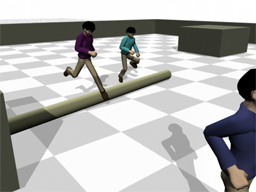Behavior Planning for Character Animation
This paper explores a behavior planning approach to automatically
generate realistic motions for animated characters. Motion clips
are abstracted as high-level behaviors and associated with a
behavior finite-state machine (FSM) that defines the movement
capabilities of a virtual character. During runtime, motion is
generated automatically by a planning algorithm that performs a
global search of the FSM and computes a sequence of behaviors for
the character to reach a user-designated goal position. Our
technique can generate interesting animations using a relatively
small amount of data, making it attractive for resource-limited game
platforms. It also scales efficiently to large motion databases,
because the search performance is primarily dependent on the
complexity of the behavior FSM rather than on the amount of data.
Heuristic cost functions that the planner uses to evaluate candidate
motions provide a flexible framework from which an animator can
control character preferences for certain types of behavior. We
show results of synthesized animations involving up to one hundred
human and animal characters planning simultaneously in both static
and dynamic environments.
Manfred Lau and James Kuffner. 2005.
Behavior Planning for Character Animation.
ACM SIGGRAPH / Eurographics Symposium on Computer Animation (SCA), 271-280.
[BiBTeX]












